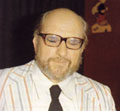Saint-Luc was interesting for other reasons,
at least to me. At the end of the year there always
was a jury of people from the trade to give grades. Those people
mostly commented and criticized. It was interesting, but the members
of the jury always kept themselves low-profile. There were also
less well-known people, who I don't really remember. But in the
final year, to be precise, the last day at Saint-Luc,
Jijé dropped by. He was absolutely fantastic.
He trashed everyone, and I mean everyone. Except for
François Schuiten.
He was the first one that told me: "That is bad;
that stinks; junk. Watch! That is badly drawn... There and there...
That doesn't work at all!" Of course I was completely nailed
to the floor, but at that moment I truely saw what I had made,
free from the schoollike view that was so common at the academy.
I told myself: "He is right. That's where you're wrong, it is
badly drawn. It's not good. There you're wrong, that doesn't work.
That's bad..." At that moment I changed what I could. I started to
see, make sketches, spending more attention on the anatomy and draw
more realistically. I arrived at a drawing style resembling the first
Rork. Then
Eddy Paape asked me to work for him.

